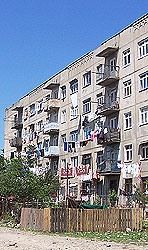Project - Dwelling Type
Because roughly half of the Georgian IDPs from Abkhazia live in collective centers and half in private housing, the Georgian case presents an opportunity for an analysis of the way in which location and dwelling type may mold social networks, identities, and livelihood strategies.
Collective centers include former hotels, dormitories, and any other building that could be turned into shelters. Interviews with IDP families living in collective centers suggest that they do rely greatly upon their "neighbors" for access to resources such as child care and information. Shared territorial identity in collective centers may result in promoting the use of kin relationships in social networks that in turn promotes the development of a more diverse set of livelihood strategies than are found in IDPs in private dwellings.
Our research on dwelling type focuses on two areas: how the social and physical spaces of lives intersect; the collective economy that has developed among people living collectively relative to those living in private dwellings.
